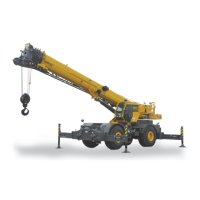2-50 Published 11-22-2016, Control # 345-12
HYDRAULIC SYSTEM RT9130E-2 SERVICE MANUAL
SERVICE BRAKE HYDRAULIC
ACCUMULATOR
Description
The service brake hydraulic accumulators are located on the
outside of the left superstructure side plate behind the cab.
The purpose of each accumulator is to provide stored
energy, an oil volume of 231 cu in (3.8 liters) at a maximum
pressure of 2750 psi (18,966 kPa), to actuate the service
brake circuits. The dual accumulator charge valve regulates
flow to the hydraulic accumulators to provide fully powered
independently separate, primary (front) and secondary
(rear), service brake circuits.
Each accumulator has two chambers divided by a piston.
One side is pre-charged to 1400 psi (9655 kPa) with high
purity nitrogen. This maintains a constant pressure in the
other chamber which is connected to the modulating brake
valve. After the accumulators are fully charged, they will
provide the necessary brake system flow and pressure to
actuate the brakes.
The accumulator consists of a tube, piston, seals, gas
charging valve, and a gas valve guard.
Maintenance
Removal
1. With the engine shutdown, deplete the hydraulic
pressure in the accumulators by depressing the service
brake pedal several times.
2. Tag and disconnect the hydraulic hose from the
accumulator. Cap or plug the line and port.
3. Remove the two nuts securing each clamp half. Remove
the each clamp half and accumulator from the turntable.
Installation
1. Position the accumulator in the clamps and secure with
the removable clamp halves and nuts.
2. Connect the hydraulic hose to the port on the
accumulator as tagged during removal.
3. Pre-charge the accumulator. Refer to paragraph titled
Pre-Charging Accumulator in Sub-Section titled
Hydraulic Pressure Adjustment.
4. Start the engine and check accumulator and hoses for
leaks. Make repairs as needed.
5. Depress the brake pedal several times, make several
turns with the steering wheel, and swing the
superstructure left and right. Verify the brakes, swing,
and front steering work properly.
Servicing
The pre-charge nitrogen pressure should be checked every
200 hours or once a month, whichever comes first. Refer to
the Sub-Section titled Pressure Setting Procedures, page 2-
21.
LOAD SENSE HYDRAULIC ACCUMULATOR
Description
The main directional control valve load sense accumulator is
located on the right hand superstructure side plate beside
the main directional control valve. The purpose of the
accumulator is to dampen the load sense signals from the
cylinders and motors to the inlet unloader. The accumulator
has two chambers divided by a piston. One side is
precharged to 600 psi (4,138 kPa) with high purity nitrogen
while the other chamber is connected to the load sense port
of the directional valve.
The accumulator consists of a tube, piston, seals, gas
charging valve, and charging valve guard.
Maintenance
Removal
1. With the engine shutdown, deplete the hydraulic
pressure in the accumulators by depressing the service
brake pedal several times.
2. Tag and disconnect the hydraulic hose from the
accumulator. Cap or plug the line and port.
3. Remove the two nuts securing each clamp half. Remove
the each clamp half and accumulator from the turntable.
Installation
1. Position the accumulator in the clamps and secure with
the removable clamp halves and nuts.
2. Connect the hydraulic hose to the port on the
accumulator as tagged during removal.
3. Pre-charge the accumulator. Refer to paragraph titled
Procedure G - For Pre-Charging Accumulator, page 2-
26.
4. Start the engine and check accumulator and hoses for
leaks. Make repairs as needed.
5. Depress the brake pedal several times, make several
turns with the steering wheel, and swing the
superstructure left and right. Verify the brakes, swing,
and front steering work properly.
Servicing
The pre-charge nitrogen pressure should be checked every
200 hours or once a month, whichever comes first. Refer to
the Sub-Section titled Pressure Setting Procedures, page 2-
21.

